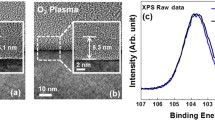Abstract
One of the reasons for the dominance of Si in microelectronics is the quality of the Si-SiO2 interface. In contrast, development of SiC-based MOSFETs for power applications is hampered primarily by poor carrier mobility at the SiC-SiO2 interface. Here we review recent calculations that elucidate the reasons of the contrasting properties of the two interfaces. In the case of Si, the interface energy is in fact lower when the interface is abrupt and smooth because of the intrinisic geometry of the Si (001) surface and the softness of the Si-O-Si angle. However, two energei-cally degenerate phases are possible, leading to domain boundaries, that are the cause of suboxide bonds, steps, and dangling bonds. In principle, these effects may be avoidable by low-temperature deposition. In contrast, the geometry and bond lengths of SiC surfaces are not suitable for abrupt and smooth interfaces, requiring the existence of a nonstoichiometric interlayer that may be the cause of the reduced mobility.
Similar content being viewed by others
References
S. T. Pantelides, M. Long, The Physics of SiO2 and its Interfaces, (Pergamon, New York, 1978).
M. DiVentra and S. T. Pantelides, Phys. Rev. Lett. 83, 1624 (1999).
F. J. Himpsel et al., Phys. Rev. B 38, 6084 (1988): A. Pasquarello et al. Phys. Rev. Lett. 74, 1024 (1995).
A. Ourmazd et al., Phys. Rev. Lett. 59, 213 (1987).
H. Akatsu and I. Ohdomari, Appl. Surf. Sci. 41/42, 357 (1989).
A. B. Gurevich et al. Phys. Rev. B 58, R 13434 (1998).
P.V. Smith and A. Wander, Surf. Sci 219, 77 (1989); Y. Miyamoto and A. Oshiyama, Phys. Rev. B 41, 12680 (1990): T. Hoshino et al., Phys. Rev. B 50, 14999 (1994): N. A. Modine, G. Zumbach, and E. Kaxiras, (unpublished)
F. Herman and R.V. Kasowski, J. Vac. Sci. Tech. 19, 395 (1985).
A. Pasquarello, M. S. Hybertsen, and R. Car, Appl. Phys. Lett. 68, 625 (1996); Phys. Rev. B56, 10942 (1996); A. Pasquarello, M. S. Hybertsen, R. and Car, Nature 396, 58 (1998)
H. Kageshima and K. Shiraishi, Phys. Rev. Lett. 81, 5936 (1998).
M. Ramamoorthy and S.T. Pantelides, Appl. Phys. Lett. 75, 115 (1999).
R. Buczko, S. J. Pennycook, and S. T. Pantelides, Phys. Rev. Lett., in press.
M.C. Payne et al., Rev. Mod. Phys. 64, 1045 (1992).
I. Ohdomari, T. Mihara, and K. Kai, J. Appl. Phys. 60, 3900 (1986) used Si-O-Si-Si bridges to build a model interface.
J. Bernhardt et al., Appl. Phys. Lett. 74, 1084 (1999).
E.H. Poindexter et al., J Appl. Phys. 52, 879 (1981)
Author information
Authors and Affiliations
Rights and permissions
About this article
Cite this article
Buczko, R., Pennycook, S.J. & Pantelides, S.T. Atomic-Scale Structure of the Si-SiO2 and SiC-SiO2 Interfaces and the Origin of Their Contrasting Properties. MRS Online Proceedings Library 592, 234–239 (1999). https://doi.org/10.1557/PROC-592-227
Published:
Issue Date:
DOI: https://doi.org/10.1557/PROC-592-227




